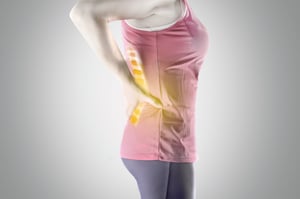 Any individual who has experienced chronic pain due to a herniated disc knows all too well how disabling and uncomfortable it can be. Lumbar disc herniation is the most common cause of sciatica1, or leg pain along the sciatic nerve, which impacts as many as 40 percent of people2 in their lifetime.
Any individual who has experienced chronic pain due to a herniated disc knows all too well how disabling and uncomfortable it can be. Lumbar disc herniation is the most common cause of sciatica1, or leg pain along the sciatic nerve, which impacts as many as 40 percent of people2 in their lifetime.
Along with sciatica, lumbar disc herniation causes other symptoms that can make it difficult to participate in daily activities and responsibilities. For example, a herniated disc can also cause foot drop (difficulty lifting the foot), weakness, tingling, numbness, and more. These symptoms can make it very challenging, and in some cases even impossible, to live a normal, pain-free life.
That’s why herniated disc prevention is critical, especially for high-risk individuals or those who have already experienced it before. This article covers the steps you can take to reduce your risk of developing a herniated disc in your spine.
7 Steps You Can Take to Prevent Lumbar Disc Herniation
While it’s not always possible to prevent a herniated disc, there are certain steps you can take3 to reduce your risk, such as:
1. Practicing good posture
It’s important to maintain good posture whether you’re walking, standing, sitting, or sleeping. Good posture keeps bones and joints correctly aligned and prevents excess wear and tear that can lead to painful spinal conditions like herniated discs. To practice good posture, stand up straight, sit with feet flat on the floor or elevated, and sleep on a firm mattress on your back or side, not your stomach.
2. Maintaining a healthy weight
Maintaining a healthy weight is important, both for your overall well-being and when taking steps to prevent a herniated disc. Excess weight puts added stress on the lumbar discs in the spine, increasing herniation risk.
Plus, some spine surgeons prefer to perform discectomy surgery for a herniated disc when patients have a body mass index (BMI) below 40, which is the threshold for severe obesity. This is because obesity is proven to increase the risk4 of postoperative complications following herniated disc surgery.
3. Using proper lifting techniques
Using proper lifting techniques is an important step in herniated disc prevention. When lifting heavy objects, always avoid bending at the waist with your knees straight, as well as lifting anything heavy above the waist level. Twisting while lifting something heavy can also make your back more vulnerable and prone to lumbar disc herniation.
An example of the proper technique for lifting objects from the trunk of a car.
Instead, bend your knees and keep your back straight to support the weight without putting pressure on your spine. Keep in mind that this is true for lifting anything, and not only for weight training.
4. Quitting smoking
Cigarette smokers have an increased risk of disc herniation due to accelerated disc degeneration5 and spinal instability. Smoking has been linked6 to impaired blood flow and decreased oxygen supply to the lumbar discs, which can cause more rapid degeneration than would occur naturally. On top of this, smokers who develop a herniated disc and seek surgical relief have increased risk of poor outcomes7 and complications like reherniation.
5. Stretching often
Example of Cat & Cow yoga stretches.
Stretching often helps keep your muscles from tensing up, especially after sitting for long periods of time. This is particularly important for those with more sedentary lifestyles who sit at a desk all day for work. Low-impact stretching programs such as yoga and Pilates are an excellent way to work stretches into your daily routine, relax your muscles, and work toward keeping your lumbar spine as healthy as possible.
6. Staying active
Maintaining an active lifestyle is not only excellent for your overall health, but also for herniated disc prevention. Regular exercise keeps your muscles strong and flexible, which helps to prevent injury and pain. Stay active by engaging in regular aerobic activity to reduce risk because a sedentary lifestyle and weak muscles contribute to herniated lumbar discs.
7. Core strength
Engaging in exercise to improve core strength, or to strengthen the abdominal, back extensor and rotator muscle groups, can reduce the risk of disc injury. The stronger your core is, the less load your disc sees with activities of daily living, ultimately lessening the risk of herniation. Your physical therapist can instruct you on a proper exercise regimen.
Athletes should take extra precautions8 to prevent disc herniation, because they’re often considered high-risk due to the frequent stresses many sports put on the lumbar spine. Some of the necessary precautions to reduce the risk of injury to the spine include warming up and stretching before playing a sport, using the proper equipment, and adopting a healthy lifestyle as a whole.
Preventing Lumbar Disc Herniation to Protect Your Spine
Herniated disc prevention is especially important as we age (along with our discs) and become more at risk for spinal conditions and degeneration. Recognizing the risk factors and taking steps to actively avoid them is not a fool-proof method, but it can greatly reduce the likelihood of disc herniation.
If you begin struggling with leg pain or any of the other common symptoms of a herniated lumbar disc, the best next step is to consult with a specialist to receive a proper diagnosis and discuss treatment options. Conservative nonsurgical treatment pathways often include many of the tips we shared in this article.
For example, smoking cessation, stretching, and staying active are all effective nonsurgical treatments for managing leg pain due to a herniated disc. By following these tips now and taking proactive steps to protect your spine from injury, you can essentially get a head start and prevent disc herniation rather than treating it after-the-fact.
If you are interested in exploring a surgical treatment option, download this free comprehensive Discectomy Guide below.
While this blog is meant to provide you with information to support your well-being while considering or waiting for spinal surgery, it is not intended to replace professional medical care or provide medical advice. If you have any questions about the information given, please ask your doctor, who is the only one qualified to diagnose and treat your pain and spinal condition.
References:
1 Roger Härtl, “Lumbar Herniated Disc Symptoms,” Spine Health, Vertias Health, 2016, https://www.spine-health.com/conditions/herniated-disc/lumbar-herniated-disc-symptoms.
2 “Sciatica: Of All the Nerve,” Harvard Health Publishing, Harvard Medical School, 2016, https://www.health.harvard.edu/pain/sciatica-of-all-the-nerve.
3 “Herniated Disk Prevention,” Cleveland Clinic, 2014, https://my.clevelandclinic.org/health/diseases/12768-herniated-disk/prevention.
4 Keith L. Jackson and John G. Devine, “The Effects of Obesity on Spine Surgery: A Systematic Review of the Literature,” Global Spine Journal 6, no. 4 (2016): 394-400, doi:10.1055/s-0035-1570750.
5 Susan Spinasanta et al, "Smoking, Tobacco Use, E-Cigarettes And Spine Surgery," Spine Universe, Remedy Health Media, updated July 16, 2019, https://www.spineuniverse.com/treatments/surgery/smoking-tobacco-use-cigarettes-spine-surgery.
6 Daniel K. Park, MD, “Herniated Disk in the Lower Back,” OrthoInfo, The American Academy of Orthopaedic Surgeons, 2018, https://orthoinfo.aaos.org/en/diseases--conditions/herniated-disk-in-the-lower-back.
7 Keith L. Jackson and John G. Devine, "The Effects Of Smoking And Smoking Cessation On Spine Surgery: A Systematic Review Of The Literature," Global Spine Journal 6, no.7, (2016): 695-701, doi:10.1055/s-0036-1571285.
8 Benjamin N. Carr III, MD, “5 Ways Athletes May Avoid Spine Injury,” Spine Health, Vertias Health, 2018, https://www.spineuniverse.com/wellness/exercise/5-ways-athletes-may-avoid-spine-injury.



Comments